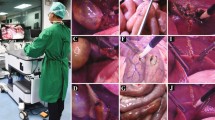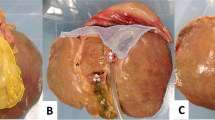Abstract
Objective
To introduce a novel laparoscopic training system with a continuously perfused ex-vivo porcine liver for hepatobiliary surgery.
Background
Existing models for laparoscopic training, such as box trainers and virtual reality simulators, often fail to provide holistic training and real haptic feedback. We have formulated a new training system that addresses these problems.
Methods
Real-Liver Laptrainer consists of a porcine liver, customized mannequin, ex-vivo machine perfusion system, and monitoring software. We made a detailed comparison of Real-Liver Laptrainer with the LapSim virtual reality simulator and the FLS Trainer Box systems. Five laparoscopic surgeons assessed the new system on multiple features. We assessed the performances of 43 trainees who used the new system to perform laparoscopic cholecystectomy (LC) three times.
Results
Real-Liver Laptrainer offered more functions and better tactile feedback than the FLS or LapSim system. All five surgeons graded the quality of the new system as realistic. The utility of the system for training was scored as 3.6 ± 1.1 on a scale of 1–5. Between the first and third attempts, the number of successfully performed LCs increased (9 vs 14 vs 23; P = .011), while the numbers of liver damage incidents (25 vs. 21 vs. 18, P = .303) and gallbladder perforations decreased (17 vs. 12 vs. 9, P = .163). The mean LC operation time significantly decreased (63 vs. 50 vs. 44, P < .0001).
Conclusion
Real-Liver Laptrainer is a feasible, stable, and practical training model that has potential for improving the laparoscopic skills of surgeons.




Similar content being viewed by others
References
Hendolin HI, Paakonen ME, Alhava EM, Tarvainen R, Kemppinen T, Lahtinen P (2000) Laparoscopic or open cholecystectomy: a prospective randomised trial to compare postoperative pain, pulmonary function, and stress response. Eur J Surg 166:394–399
Lee JH, Yom CK, Han HS (2009) Comparison of long-term outcomes of laparoscopy-assisted and open distal gastrectomy for early gastric cancer. Surg Endosc 23:1759–1763
Crothers IR, Gallagher AG, McClure N, James DT, McGuigan J (1999) Experienced laparoscopic surgeons are automated to the “fulcrum effect”: an ergonomic demonstration. Endoscopy 31:365–369
Perkins N, Starkes JL, Lee TD, Hutchison C (2002) Learning to use minimal access surgical instruments and 2-dimensional remote visual feedback: how difficult is the task for novices? Adv Health Sci Educ Theory Pract 7:117–131
Stefanidis D, Scerbo MW, Korndorffer JR Jr, Scott DJ (2007) Redefining simulator proficiency using automaticity theory. Am J Surg 193:502–506
Munz Y, Kumar BD, Moorthy K, Bann S, Darzi A (2004) Laparoscopic virtual reality and box trainers: is one superior to the other? Surg Endosc 18:485–494
Dunkin B, Adrales GL, Apelgren K, Mellinger JD (2007) Surgical simulation: a current review. Surg Endosc 21:357–366
Gallagher AG, Ritter EM, Champion H, Higgins G, Fried MP, Moses G, Smith CD, Satava RM (2005) Virtual reality simulation for the operating room: proficiency-based training as a paradigm shift in surgical skills training. Ann Surg 241:364–372
Seymour NE (2008) VR to OR: a review of the evidence that virtual reality simulation improves operating room performance. World J Surg 32:182–188
Rassweiler J, Klein J, Teber D, Schulze M, Frede T (2007) Mechanical simulators for training for laparoscopic surgery in urology. J Endourol Soci 21:252–262
Schijven M, Jakimowicz J (2003) Virtual reality surgical laparoscopic simulators. Surg Endosc 17:1943–1950
Dankelman J (2008) Surgical simulator design and development. World J Surg 32:149–155
Velazquez-Avina J, Sobrino-Cossio S, Chavez-Vargas C, Sulbaran M, Monkemuller K (2014) Development of a novel and simple ex vivo biologic ERCP training model. Gastrointest Endosc 80:1161–1167
Vapenstad C, Hofstad EF, Bo LE, Chmarra MK, Kuhry E, Johnsen G, Marvik R, Lango T (2013) Limitations of haptic feedback devices on construct validity of the LapSim(R) virtual reality simulator. Surg Endosc 27:1386–1396
Vapenstad C, Hofstad EF, Lango T, Marvik R, Chmarra MK (2013) Perceiving haptic feedback in virtual reality simulators. Surg Endosc 27:2391–2397
Acknowledgements
The authors want to thank all medical students and surgeons for their participation in all trials and the staff at Institute of Advanced Surgical Technology and Engineering of the First Affiliated Hospital of Xi’an Jiaotong University for the help and facilities to carry out this study.
Author information
Authors and Affiliations
Corresponding authors
Ethics declarations
Disclosures
This study was supported by a grant from the National Natural Science Foundation of Equipment awarded to Yi Lv (Grant No. 81127005). Wenyan Liu, Xinglong Zheng, Rongqian Wu, Yinbin Jin, Shu Kong, Jianpeng Li, Jianwen Lu, Huan Yang, Xianghua Xu, Yi Lv, and Xiaogang Zhang have no conflicts of interest or financial ties to disclose.
Rights and permissions
About this article
Cite this article
Liu, W., Zheng, X., Wu, R. et al. Novel laparoscopic training system with continuously perfused ex-vivo porcine liver for hepatobiliary surgery. Surg Endosc 32, 743–750 (2018). https://doi.org/10.1007/s00464-017-5731-6
Received:
Accepted:
Published:
Issue Date:
DOI: https://doi.org/10.1007/s00464-017-5731-6




